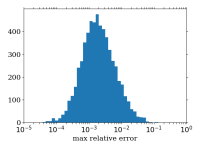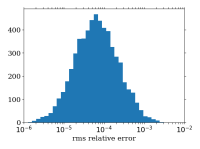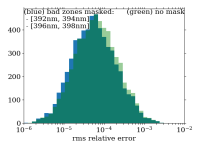-
Type:
Task
-
Status: Done (View Workflow)
-
Priority:
Normal
-
Resolution: Done
-
Affects Version/s: None
-
Fix Version/s: None
-
Component/s: None
-
Labels:
In PIPE2D-1053, I made a set of flux models, interpolating spectra on a fine grid of parameters (Teff, log(g), metalicity, alpha). The interpolator (RBF) has hyperparameters such as kernel type and kernel size. Because the "kernel size" (epsilon) is only isotropic, I set epsilon to a fixed constant, and instead introduced hyperparameters teffScale, loggScale, mScale and alphaScale by which to multiply the four parameters (Teff, log(g), metalicity, alpha) respectively. In PIPE2D-1053, I experimented a little and set kernel="multiquadric", teffScale=0.5e-3, loggScale=0.5, mScale=2 and alphaScale=0.5 with epsilon=2.
The hyperparameters are, however, not optimal. For low temperature and low log(g), I know that the max relative error max_{λ} |(rbf(λ) - f(λ)) / f(λ)| is sometimes above 100%, where f(λ) is an AMBRE spectrum at (Teff, log(g), metal, alpha), and rbf(λ) is the RBF interpolation at (Teff, log(g), metal, alpha) guessed from all the other combinations of parameters than (Teff, log(g), metal, alpha). I must tune the hyperparameters more carefully.
The smaller the scale parameters are, the better the RBF interpolation is. As the scale parameters get smaller, however, the condition number of the matrix of the linear equations to be solved gets worse (wikipedia says). In searching for the best scale parameters, I set the initial guess to somewhat big value, assuming that the condition number was small there, and hoping that the optimizer would optimize the parameters gradually to a smaller values as long as the linear equations were soluble. The optimization program has been running for a week, and it now seems to have found the minimum.
The optimized problem was as follows: Minimize
sum_{i = 1}^{6000} loss(i), where i is the name of an AMBRE spectrum. We compute loss(i) in this way: We put i aside and make an RBF model from all the other AMBRE spectra. We interpolate the spectra at i and compare the guess and the truth (We take care that this interpolation won't be extrapolation. If this interpolation is extrapolation, i is excluded from the sum). Let loss(i) = \sum_{λ} (guess(λ) - truth(λ))^2 / truth(λ)^2. Because it would take all too long a time if we were to compute this last sum in full, we use only the shortest 1/3 of the entire wavelength range (where absorption lines densely exist) and abandon 9/10 of the samples in this range.
The new fluxmodeldata package, when made, will be compatible to the previous one (PIPE2D-1053). Programs need not changing.
Edit: Uploaded the new version of fluxmodeldata here: https://hscdata.mtk.nao.ac.jp/hsc_bin_dist/pfs/fluxmodeldata-ambre-20220714-full.tar.xz
Some quality assessments of this package are shown in the comments of this issue.
- relates to
-
PIPE2D-1231 Reduce memory usage of fitPfsReferenceFlux
-
- Done
-





